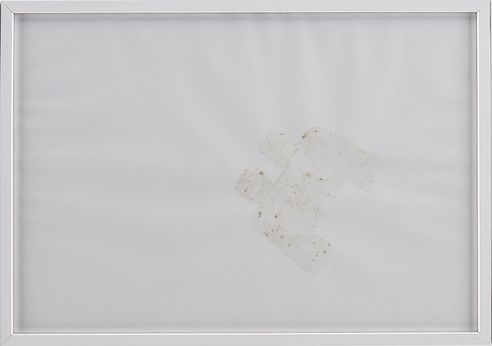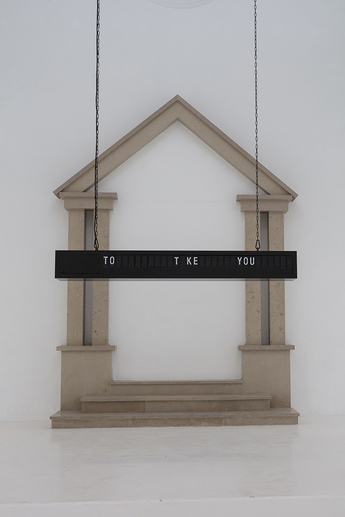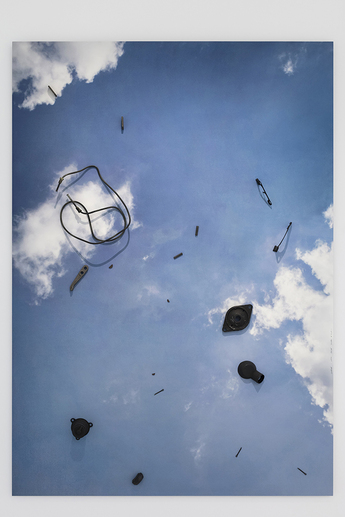-
From Current Issue
-
- Editor’s Letter Fire in the Heart
- Reviews I Gusti Ayu Kadek Murniasih
- Reviews 11th Seoul Mediacity Biennale: “One Escape at a Time”
- Dispatch Networked China
- One on One Monira Al Qadiri on Yukio Mishima
- Essays The rise of independent art spaces in pandemic-era Shanghai
- Features Tuan Andrew Nguyen
- Table of Contents
- Web Exclusives
- Archive
- Subscribe

R
E
V N
E
X
T
Installation view of SHILPA GUPTA’s 1:384943, 2017, steel and brass, 7 meters, at “Drawing in the Dark,” Centre d’Art Contemporain – la Synagogue de Delme, 2017–18. Photo by OH Dancy. Courtesy the artist and Centre d’Art Contemporain – la Synagogue de Delme.
Shilpa Gupta’s solo exhibition “Drawing in the Dark” at Centre d’Art Contemporain – la Synagogue de Delme in northeastern France was an articulation of the Mumbai-based artist’s in-depth, ongoing investigation into sensitive political and transnational issues, particularly concerning the peripheral borderlands that India shares with Bangladesh. The show was an extension of the 56th Venice Biennale project titled “My East is Your West,” which Gupta co-presented with Pakistani artist Rashid Rana.
Visitors were primed for the exhibition’s discussions of movement, displacement and clandestine operations right at the entrance, where a long steel section was diagonally positioned, barring the façade and partially obstructing access. Titled 1:384943 (2017), the work is an imposing, performative manifestation of Gupta’s survey of the India-Bangladesh frontier, which, at around 4100-kilometers in length, is the fifth longest border in the world.
The form of this divisive line originated in 1947—the same year that India gained independence from Great Britain, and Pakistan and India were partitioned—and was designated by the chairman of the British Boundary Commission Cyril Radcliffe, although it wasn’t until 1974, three years after Bangladesh’s proclamation of independence and subsequent war for liberation, that Bangladesh was fully recognized as an independent state, with the Islamic Republic of Pakistan finally relinquishing its claim over what used to be called East Pakistan.
Complications between India and its new neighbor began soon thereafter. Sections of the border have become the notorious focal points of illegal activity, such as the smuggling of narcotics, medicines, arms, foods and livestock (especially cattle). Certain areas are also used as part of human trafficking and illegal immigration routes. The construction of the India-Bangladesh barrier—a barbed-wire fence, to be built by India—was scheduled for completion in June 2017 but has been delayed to 2019.
Gupta explores these spatial and social parameters, synchronously engaging with human activity as observed from an authoritative, top-down perspective and from the viewpoint of local populaces, honing in on where the two converge, such as in the frequent instances when illegal trading and trespassing are overseen and handled according to personal benefit. Map Tracing # 5 – FR (2017) is a thin piece of copper pipe lying serenely in one of the gallery’s corners, twisted into an outline loosely suggestive of the shape of Bangladesh. The land’s over-50 transboundary rivers make defining clear outlines severely complicated—a fact reflected in the form of the sculpture, which deviates from representations of the country on standard world maps. By evoking fluidity and malleability, the work renders the modus operandi of national authorities who decide subjectively what to control and what to overlook.
In line with the concept of movement and borders is 24:00:01 (2010–12), which comprises a suspended flapboard similar to those found in airport lounges and train stations. The installation does not announce the arrival or departure of anybody; rather, we encounter fragments of words and phrases such as “To fall in love with you” and “To take you” that merge into each other. The work is a statement on the construction and deconstruction of identity, the mapping of human emotion and its dissolution and annihilation. Another exhibit, 1:2138 (2017), featuring shredded pieces of saris in a glass case, highlights not only the illegal trade of handmade garments between India and Bangladesh, but also the traditions and historical background that the two share—it is these aspects of the local populations’ daily lives that are difficult to erase despite political circumstances.
Characteristics that define the quotidian in both countries also encompass the use of common mechanical equipment. A set of new C-prints titled Unnoticed (2017), illustrating vivid skies, is studded with pieces of spare motor parts. The artist juxtaposes the act of illegal trade against the tranquility and the unity of the sky, which nevertheless bears the potential to transform into a point of surveillance through technological means. Another body of work on paper, Untitled (2017), is a series utilizing pigment from marijuana extracts, discreetly profiling objects associated with border patrols, such as a pair of binoculars and a handheld radio. Constantly canvassing ideas over border politics and concealed power games by those in charge, these works are permeated with an irony that challenges socioeconomic and cultural constraints.
Unquestionably, “Drawing in the Dark” was an exhibition that embraced the criticism of shifting geographies and realities. It confronted the viewer with a different and unsettling perspective. And although all this reflects Gupta’s origins and concerns, it would perhaps be more interesting to see whether this narrative progresses to transgress its own boundaries, possibly drawing parallels with the wider context of nationhood and realities in other parts of the world.
Shilpa Gupta’s “Drawing in the Dark” is on view at Centre d’Art Contemporain – la Synagogue de Delme until February 18, 2018. The exhibition was presented from February 11 to April 16, 2017, at Ghent’s Kiosk Gallery and from April 29 to July 16 at the Bielefelder Kunstverein.
To read more of ArtAsiaPacific’s articles, visit our Digital Library.







